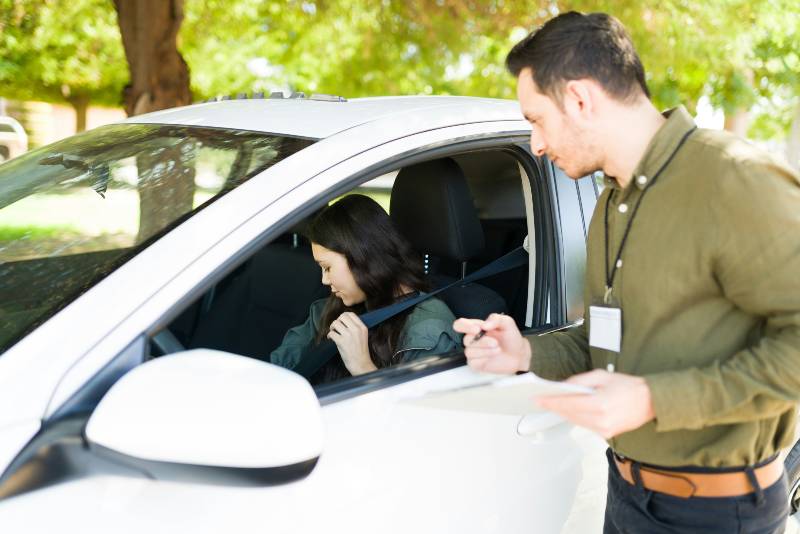Getting your driver’s license (Class C) can be an exciting milestone.
The average time to get a driver’s license in California ranges from two to six months. The length of time depends on factors like study habits for the written test, practice time for the driving test, and individual readiness.
This process involves meeting specific prerequisites, passing several tests, and ensuring you have the necessary documents and skills to hit the road safely. Let’s look at the steps you’ll need to take and what you can expect along the way.
How to Apply for a Driver’s License?
Before you can grab the keys and drive off into the sunset, you’ll need to understand the conditions and necessary steps to apply for your driver’s license.
Here’s what the journey typically includes:
Firstly, if you’re a teenager and a new driver, you’ll need to enroll in a driver’s education program to learn the essentials of road safety, traffic laws, and driving etiquette. In California, teens must be at least 15 ½ years old to qualify for a provisional permit, which allows you to practice driving under certain restrictions.
Once you’ve met the age requirement and completed driver’s education, you can apply for a learner’s permit by scheduling an appointment at your local Department of Motor Vehicles
(DMV) office. Here’s what you’ll need to bring with you:
- Proof of your identity, such as a birth certificate or passport.
- Proof of residency, which could include a school document or parent’s utility bill.
- A completed Driver License or Identification Card Application (form DL-44), which requires your parent or guardian’s signature if you’re under 18.
- The application fee, which will cover the cost of the written test and provisional permit.
After submitting your application and documents and paying the fee, you’re ready for the next steps: passing the written knowledge test and the vision test.
3 Tests You Need to Pass to Get Your Driving License
To get behind the wheel legally in California, you’ll have to clear some hurdles that signify you’re both knowledgeable about and capable of safe driving.
This phase is critical, as it ensures that only those equipped with the necessary understanding of rules and practical skills receive their license.
In this process, you’ll encounter three vital assessments: the vision test, the written test, and the driving test. All are designed to evaluate different aspects of your qualification as a driver.
Vision Test
Your eyes are your most important asset on the road, guiding you safely from point A to point B. In the vision test, your eyesight will be evaluated to ensure it meets the minimum requirements for driving.
You’ll be asked to read a standard eye chart to demonstrate you have 20/40 vision or better, whether you’re wearing corrective lenses or not.
It’s a quick test, but if your vision doesn’t pass the standard, don’t worry, you might simply be required to obtain glasses or contact lenses to correct your vision before you’re allowed on the road.
Written Test
Once your vision is cleared, the next step to proving your readiness for a driver’s license involves taking the written (or knowledge) test. This test will quiz you on the nuts and bolts of driving, such as the California traffic laws, road signs, and best practices behind the wheel.
This test ensures you have a solid understanding of how to operate a vehicle safely and legally.
Preparation is key here. The California Driver Handbook is the official guide and contains all the information you’ll encounter on the test. Dedicate time to studying it, cover-to-cover, and don’t hesitate to re-read sections that you find challenging.
In addition, online practice tests can be incredibly beneficial. They not only familiarize you with the format of the actual test but also help reinforce what you’ve learned. Expect to answer multiple-choice questions, and remember, each one you answer correctly gets you closer to becoming a licensed driver.
Driving Test
The final challenge is the driving test, a practical demonstration of your driving skills. It’s the moment when you get into a car with a DMV examiner and show that you can handle the vehicle safely and competently.
Before you get to this stage, you must have practiced driving on the road. California requires teen drivers to have completed at least 50 hours of supervised practice, including 10 hours at night, with a licensed adult over 25 years old.
All these practice hours need to be logged and signed off by your supervisor, typically a parent or guardian, to show that you’ve gained the experience needed to handle a variety of driving conditions.
On test day, you’ll be evaluated on a range of driving scenarios and skills, including but not limited to: starting and stopping, backing up, making safe lane changes, turning, signaling, and adhering to speed laws.
You’ll also need to demonstrate proper use of the vehicle’s controls and consistently check mirrors for awareness of your surroundings. The examiner is observing how you react to traffic, pedestrians, and other road users to ensure you can make sound decisions under real-world circumstances.
Keep calm and confident when taking the driving test. Nervousness is natural, but your ability to remain composed will let your skills shine through. Prior to starting the test, ensure your test vehicle is in good working order, as any defects could lead to an automatic fail before you even hit the road.
If the unfortunate happens and you don’t pass the driving test, don’t be disheartened. You are allowed to retake the test, but be aware there is a mandatory 14-day waiting period before your next attempt. Plus, you’ll need to pay a retest fee of $7.
This waiting period gives you an opportunity to practice and improve on the areas where you might have made mistakes.
If you fail the driving test three times, however, your application will be rendered invalid, and you’ll have to start the application process over again, which includes paying a new application fee.
Given that retaking the test can extend the amount of time it takes to get your license, it’s worth taking the preparation seriously. Work on any weaknesses identified by the examiner and consider getting more practice in those specific areas.
You might also benefit from additional lessons with a driving instructor who can give professional guidance tailored to your needs.
How Long Does Getting a Driver’s License Take After Passing the Driving Test?
Once you’ve passed the driving test, you’re on your way to receiving your official California Class C driver’s license.
Shortly after passing, the DMV will issue you a temporary driver’s license, which is valid for 60 days. This temporary license allows you to drive just like you would with a permanent license while you wait for your official license to arrive in the mail.
Your new, permanent driver’s license should arrive within 3 to 4 weeks. If it doesn’t show up within that timeframe, patience is key, but don’t hesitate to take action. After 60 days, if there’s still no sign of your license, you should call the DMV at 1-800-777-0133 to inquire about the status.
The wait can be a period of anticipation, but also a time to practice and reinforce good driving habits. While you’ve earned the privilege to drive without supervision, remember that being a responsible driver is a continual learning process.
Take this time to familiarize yourself with different roads, traffic conditions, and perhaps even explore defensive driving courses, which can further enhance your skills and even provide discounts on car insurance.
Conclusion
When your driver’s license does arrive, it’s not just a piece of plastic with your photo on it; it represents your commitment to safety and responsibility on the road. Welcome to the world of driving – stay safe and enjoy the journey!




